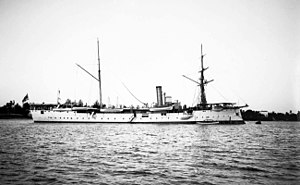Bussard-class cruiser
 SMS Bussard in Dar es Salaam
| |
| Class overview | |
|---|---|
| Preceded by | Schwalbe class |
| Succeeded by | SMS Gefion |
| Built | 1888–1895 |
| Completed | 6 |
| Lost | 3 |
| Scrapped | 3 |
| General characteristics | |
| Type | Unprotected cruiser |
| Displacement |
|
| Length | 82.60 m (271 ft) |
| Beam | 12.50 m (41 ft) |
| Draft | 4.45 m (14 ft 7 in) |
| Installed power |
|
| Propulsion |
|
| Speed | 15.5 knots (28.7 km/h; 17.8 mph) |
| Range | 2,990 nmi (5,540 km) at 9 knots (17 km/h; 10 mph) |
| Complement |
|
| Armament |
|
The Bussard class of
All six ships served abroad for the majority of their careers, primarily in Africa and the south Pacific, where they assisted in the suppression of uprisings such as the
Cormoran was based in
Design
Through the 1870s and early 1880s,
The Bussard class was designed for service abroad and the design for the Bussard class was prepared in 1888. The ships were significantly larger and faster than the Schwalbe class, but mounted the same battery of guns—though only Bussard carried the same type of guns—the rest carried a newer,
General characteristics

The ships of the Bussard class all differed slightly in their characteristics. The first two ships,
The cruisers' hulls were constructed with transverse steel frames with yellow pine planking up to the upper deck. A layer of
Propulsion
Their propulsion system consisted of two horizontal 3-cylinder
The propulsion system provided a top speed of 15.5 kn (28.7 km/h; 17.8 mph), though all six ships exceeded their design speeds while on
Armament
The first ship was armed with a
Ships

| Name | Builder[5] | Laid down[6] | Launched[6] | Commissioned[6] |
|---|---|---|---|---|
| Bussard | Danzig
|
1888 | 23 January 1890 | 7 October 1890 |
| Falke | Kaiserliche Werft, Kiel | 1890 | 4 April 1891 | 14 September 1891 |
| Seeadler | Kaiserliche Werft, Danzig | 1890 | 2 February 1892 | 17 August 1892 |
| Condor | Blohm & Voss, Hamburg
|
1891 | 23 February 1892 | 9 December 1892 |
| Cormoran | Kaiserliche Werft, Danzig | 1890 | 17 May 1892 | 25 July 1893 |
| Geier | Kaiserliche Werft, Wilhelmshaven
|
1893 | 18 October 1894 | 24 October 1895 |
Service history

All six ships of the class spent the majority of their careers abroad, primarily in Germany's colonial possessions in Africa and the Pacific. Seeadler visited the United States in March 1893, along with the
In November 1897, Cormoran took part in the seizure of the
Cormoran and Geier were modernized between 1907 and 1909; only Falke and Condor never returned for major dockyard work.
After the outbreak of
Notes
- ^ Nottelmann, pp. 102–103.
- ^ Sondhaus, pp. 166–167.
- ^ Gröner, pp. 93–99.
- ^ a b Lyon, p. 253.
- ^ a b c d e f g h Gröner, p. 97.
- ^ a b c d Gröner, pp. 97–98.
- ^ Sondhaus, p. 206.
- ^ Clowes et al., p. 414.
- ^ Hildebrand, Röhr, & Steinmetz Vol. 7, pp. 152–153.
- ^ Hildebrand, Röhr, & Steinmetz Vol. 2, p. 193.
- ^ Nunez, p. 76.
- ^ Hildebrand, Röhr, & Steinmetz Vol. 7, p. 154.
- ^ Marley, pp. 924–925.
- ^ Hildebrand, Röhr, & Steinmetz Vol. 2, p. 191.
- ^ Vego, p. 124.
- ^ Gröner, p. 98.
- ^ Schurz.
References
- OCLC 1296915.
- ISBN 978-0-87021-790-6.
- Hildebrand, Hans H.; Röhr, Albert & Steinmetz, Hans-Otto (1993). Die Deutschen Kriegsschiffe: Biographien – ein Spiegel der Marinegeschichte von 1815 bis zur Gegenwart [The German Warships: Biographies − A Reflection of Naval History from 1815 to the Present] (in German). Vol. 2. Ratingen: Mundus Verlag. ISBN 978-3-8364-9743-5.
- Hildebrand, Hans H.; Röhr, Albert & Steinmetz, Hans-Otto (1993). Die Deutschen Kriegsschiffe: Biographien – ein Spiegel der Marinegeschichte von 1815 bis zur Gegenwart [The German Warships: Biographies − A Reflection of Naval History from 1815 to the Present] (in German). Vol. 7. Ratingen: Mundus Verlag. ISBN 978-3-7822-0267-1.
- Lyon, Hugh (1979). "Germany". In Gardiner, Robert; Chesneau, Roger; Kolesnik, Eugene M. (eds.). Conway's All the World's Fighting Ships 1860–1905. Greenwich: Conway Maritime Press. ISBN 978-0-85177-133-5.
- Marley, David (2008). Wars of the Americas: A Chronology of Armed Conflict in the Western Hemisphere, 1492 to the Present. Santa Barbara: ABC-CLIO. ISBN 978-1-59884-100-8.
- Nottelmann, Dirk (2020). "The Development of the Small Cruiser in the Imperial German Navy". In Jordan, John (ed.). Warship 2020. Oxford: Osprey. pp. 102–118. ISBN 978-1-4728-4071-4.
- Nunez, Severo Gómez (1899). The Spanish–American War: Blockades and Coast Defense. Washington, DC: Washington, Govt. Print. Off.
- "Schurz". Dictionary of American Naval Fighting Ships. Navy Department, Naval History and Heritage Command. Retrieved 28 March 2022.
- Sondhaus, Lawrence (1997). Preparing for Weltpolitik: German Sea Power Before the Tirpitz Era. Annapolis: Naval Institute Press. ISBN 978-1-55750-745-7.
- Vego, Milan N. (1996). Austro-Hungarian Naval Policy, 1904–14. London: Frank Cass Publishers. ISBN 978-0-7146-4209-3.
Further reading
- ISBN 978-1-68247-745-8.
